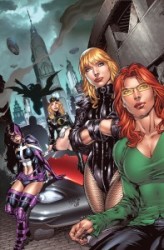I attended the Four Color Reality Panel at San Diego Comic-Con 2009. It was described like this:
6:30-7:30 Four Color Reality: Making Comics Relevant to Readers Across Cultures— Comic book stories have become the core of American pop culture—is there a big-budget spectacular that doesn’t in some fashion owe its existence to comic book roots these days? But sales of traditional-format comic books themselves have been in decline for years. This panel explores one reason for this shrinking market: the divergence between the identities of mainstream comic icons, who are typically straight, white, male, and American, and the demographic makeup of a new generation of readers. How can the comic book industry connect with changing audiences—not just of diverse races and backgrounds, but of different cultural and national origins as well? Moderated by Jeff Yang (editor-in-chief, Secret Identities: The Asian American Superhero Anthology). Panelists include Dwayne McDuffie (Milestone Comics, JLA, Ben 10: Alien Force), Gail Simone (Wonder Woman), Gene Yang (American Born Chinese, The Eternal Smile), Stuart Moore (Wolverine: Noir, The 99), and Jai Nitz (Blue Beetle, El Diablo). Room 3
Jeff Yang had a powerpoint presentation that kicked a few facts to start off the panel. One was a comparison of readerships between now and fifty years ago. Back then, comics were read by both boys and girls, at about a 50/50 ratio. In 2008, or 2009, I forget the exact year he quoted, it’s 90/10 in favor of boys. 90% of comics readers. He also showed a few quotes. I have the Paul Levitz quote exactly, since I took a picture of it, but I may have slightly paraphrased/cropped the Gary Groth quote.
Like all American media, [comics have] reflected the culture, which means there were things in the 1930s and the 1940s and the ’50s I’m sure we’d be less proud of today…
But in modern times, there have been either heroes or supporting characters introduced in our line that represent different ethnic groups and the world.
-Paul Levitz
It’s the chicken-and-egg question. The market is mostly teenage white boys. The reason is that the content has been aimed at white teenage boys. That’s why women and black adults don’t read comics. Most literate, intelligent people don’t read comics. We’re trying to change that, but it’s really difficult to do.
-Gary Groth.
Near as I can tell, Yang pulled the quotes from Facing Difference, a text book that was written in… 1997. The specific article is from the November 14th, 1993 edition of the Los Angeles Times.
One more time: November 14th, 1993. That’s sixteen years ago, give or take a few months. So, let’s get into my problems with the panel, and then loop back around into specifically talking about those numbers, and what they mean.
My (former) biggest problem with the panel is the way it seemed to conflate superheroes with comics. I didn’t quite believe it, but I took the 90% number at face value during the panel, despite my reservations. But even then, there is no way that number is accurate for comics in general. Maybe, maybe, for superheroes, but not for comics, which cover a range of genres and interests. Even leaving out manga, which is a dumb thing to do but something people do anyway, you aren’t going to see 90:10. You aren’t seeing 50:50, but you definitely aren’t seeing 90:10.
And even then, should we be looking at superheroes for racial sensitivity, anyway? This past year has convinced me that the only sensible answer is… no. Superhero comics, by and large, aren’t built for nuance. They are built to punch bad guys, be deconstructed occasionally, and to have large explosions. Nine times out of ten, superheroes are going to approach a subject from a black and white point of view, there is right and there is wrong, and that really isn’t how race and racism works. You can’t beat up racism. There are too many shades of gray, too many varied experiences, and too much baggage for that to ever happen. Sorry. Time to look elsewhere. There’ll be the occasional gem, but then there will also be Superman making proclamations and an entire generation rolling their eyes so hard that they go blind.
My new biggest problem with the panel, the problem I didn’t have before I started doing research with this post, is the research that apparently went into those figures that helped to set the stage for it. Numbers (with no sources) and quotes on the state of the industry from 1993 have about as much to do with the numbers and state of the industry in 2009 as the murder rate in New York City in 1936 has to do with the crime in NYC in 2009.
It’s irrelevant, and using those numbers, comics or murder rate alike, to bolster your point is intellectually dishonest.
Since 1993, we’ve seen an industry contract and nearly collapse. We’ve seen the rise of graphic novels and trade paperbacks as a viable way of reading and producing comics. We’ve seen a burst of movies based on comics. We’ve seen Time Magazine give Alison Bechdel’s Fun Home book of the year. Not Comic Book of the Year– Book of the Year. We’ve seen an explosion of fandom thanks to the internet. That explosion led to an explosion of female fandom online, with Scans Daily, Girl Wonder, and When Fangirls Attack probably being the three highest profile sites focused around girls’n’comics. Manga wasn’t a going concern in 1993. “Real” publishers didn’t care about anything but Maus in 1993. Bone hadn’t sold several million copies in actual book stores. Batman: The Animated Series was just getting going. And so on, and so on, and so on.
1993 isn’t 2009, and you cannot, absolutely cannot, use 1993 to make points about 2009. Those numbers? They were valid, once. Then that time passed, we moved on, and we’re in a different world now. 90% of comics readers being male in 1993, which I feel is already a dubious number but that’s just off gut instinct, has zip to do with whatever the ratio of male to female is these days.
I can understand where Yang was coming from with this. Race and gender and comics? It’s better than it was in the ’40s, yes, but it could always be better. But, pulling out figures from 16 years ago and using them to frame and position a discussion about the comics world of today is a mistake. It’s dishonest. It’s arguing against, what, a strawman? It was true at one point, perhaps, but isn’t now. It’s not a valid position to argue from.
And I mean, I’m ostensibly on Yang’s side. Should comics do better with regards to whatever ism comes to mind? Yes! Absolutely! Let’s get that range of portrayals going. But, to argue from data from 1993? That’s not how it works. If I’m on your side, and I have huge issues with your data, imagine what a theoretical nay-sayer is going to say.
Things are, and have been, getting better. I’d like to think that readers are getting smarter and more, for lack of a better word, diverse. My personal experience has certainly suggested that, and the experience of the circles that I run in.
But, really, we’ve got to do better. Halfway research and outdated figures don’t cut it, not even remotely. It doesn’t prove anything, and it doesn’t say anything beyond “Man, yesterday sucked, didn’t it?”



